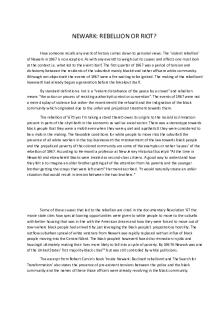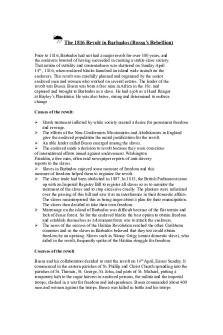Newrak RIOT OR Rebellion PDF

| Title | Newrak RIOT OR Rebellion |
|---|---|
| Author | Faizan Qasim |
| Course | Writing,Speaking, Thinking I |
| Institution | New Jersey Institute of Technology |
| Pages | 4 |
| File Size | 53.1 KB |
| File Type | |
| Total Downloads | 34 |
| Total Views | 156 |
Summary
Download Newrak RIOT OR Rebellion PDF
Description
NEWARK: REBELLION OR RIOT? How someone recalls any event of history comes down to personal views. The ‘violent rebellion’ of Newark in 1967 is no exception. As with any event, to weigh out its causes and effects one must look at the context i.e. what led to the event itself. The first quarter of 1967 was a period of tension and dichotomy between the residents of the suburbs, mainly black, and rather affluent white community. Although not objective, the events of 1967 were a fire waiting to be ignited. The making of the rebellion, however, had already begun a generation before the breakout itself. By standard definition a riot is a “violent disturbance of the peace by a crowd” and rebellion means “the action or process of resisting authority, control or convention”. The events of 1967 were not a mere display of violence but rather the resentment, the refusal, and the indignation of the black community which originated due to the unfair and prejudiced treatment towards them. The rebellion of ’67, yes I'm taking a stand there, owes its origins to the racial discrimination present in parts of the city, both in the economic as well as social sector. There was a stereotype towards black people that they were a mob, even when they were quiet and apathetic, they were considered to be a mob in the making. The favorable conditions for white people to move into the suburbs, the presence of all white workers in the top businesses, the mistreatment of the law towards black people and the prejudiced poverty of the colored community are some of the examples or rather ‘causes’ of the rebellion of 1967. According to Herman, a professor at New Jersey Historical Society, "At the time in Newark, and elsewhere, blacks were treated as second-class citizens. A good way to understand how they felt is to imagine an older brother getting all of the attention from his parents and the younger brother getting the scraps that were left over," Herman described. "It would naturally create an unfair situation that would result in tension between the two brothers."
Some of these causes that led to the rebellion are cited in the documentary Revolution ‘67 the movie state cites how special loaning opportunities were given to white people to move to the suburbs with better housing that was in line with the American dream and how they were forced to move out of town where black people had arrived, by just leveraging the black people’s preposterous hostility. The outflow suburban sprawl of white veterans from Newark was rapidly replaced with an influx of black people moving into the Central Ward. The black people, however, faced discrimination in jobs and housing, ultimately making their lives more likely to fall into a cycle of poverty. By 1967, Newark was one of the United States’ first majority-black cities[1] but was still controlled by white politicians. The excerpt from Robert Curvin's book ‘Inside Newark: Decline, rebellion, and The Search for Transformation’ also states the presence of pre-existent tensions between the police and the black community and the names of these those officers were already revolving in the black community.
Despite being one of the first cities in the country to hire black officers, the police department’s demographics remained at odds with the city's population leading to poor relations between black people and the Police Department. Only 11%[2] of the officers were black while more than half the city's population was black. According to Curvin, one of the factors of riots is the role of social control agents, particularly police and law enforcement, which was eminent in the city at the time. Another source of conflict between the city and its residents grew out of the city plan to build the New Jersey College of Medicine and dentistry. The original plan for the building displaced an estimated 22,000 residents and call for approximately 150 acres of land in the densely populated black and Hispanic areas of the Central Ward of Newark. The emotional response of the community was a sign of the things about to come. James Walker, a resident of the area, said, “I say here that if you don't give us housing in this city of Newark prior to your Medical College, that your Essex County College, that blood will run down the streets of Newark, your blood and my blood, and I state this.” Another citizen Aubrey Adams stated “The black people are sick and tired and angry at the old structure that has enslaved and suppressed them for over 300 years. So, you think if it happens again, you can turn the National Guard on them, on us, but, gentlemen, when revolt comes, bloodshed will accompany it. Will it not be justified?[3]
The incident which eventually began to riots was the arrest of John William Smith on the evening of July 12. Once arrested, he was beaten by the officers and taken to the 4th police precinct where he was charged with assaulting the officers and making insulting remarks.[4] Rumors of an incapacitated Smith being dragged into the precinct and being beaten to death spread like wildfire from Hayes Homes to the rest of the community. A protest was held outside the precinct which then escalated into the violent rebellion. According to Curvin's account, the rock throwing and stick swinging had already begun that day. The next day when NCUP announced a mass protest rally was when things got pretty bad pretty fast. Looting, firing, physical assaults, etc. Pure chaos. The unsolicited and unmonitored reaction of the police resulted in more than 17,000 bullets (other than that, large amounts were not recorded) were fired in a span of few days. The police department's head himself accepted that they were not prepared for situations like this. The beating and shooting by the police forced the masses to revolt back in the situation deteriorated further. When a 12-year-old boy is left wounded, bleeding on the road by the very police that was there to protect him what do you expect the reaction of the people to be? [5] As one of the police’s own explained, it was a matter of pleasure. They would joke about it and at the end of the day one would ask, “How did the duck hunting go?” and the other would say, “It went well.” They hadn’t been given any specific discrete orders regarding shooting, so they automatically asserted that they had license to kill. Calling 3000 National Guardsmen was another mistake that proved to be futile. The National Guard, like the police, had no idea of riot control and law of the jungle was instated. The presence of tanks, yes, tanks, on the roads of Newark raised the bar in terms of the magnitude of the riot, which caused the black people, even those who weren't involved in rioting to think of themselves as potential lawbreakers and inherently dangerous. This all, therefore, led the people of the community to ‘rebel’ against them.
Before 1967 the political and economical conditions of Newark were catastrophic. Top positions were held by the white community the minority of blacks were not man enough to stand up for their racial brothers. However, after their rebellion, the situation changed. The black community decidedly became more militant: new nationalistic leadership emerged. Most of NCUP’s white organizers left the city. The next mayor and henceforth all mayors, were black. The report of the Governor’s Select Commission on Civil Disorders came out to settle the dispute of the Medical School as well as other issues. The final report, over a feet tall tower of papers, closely scrutinized the inadequacies in performance of the city agencies, condemned the city administration for displaying insensitivity to the black community and concluded that the police-people relations in Newark were of ‘resentment’ and ‘bitterness’. It strongly condemned the conduct of the state police as well as the National Guard and how inhumanly they tackled the situation, without any possible explanations. The use of well out of proportion for the task at hand was discussed as well. Companies and construction sites were enforced with the hiring of black people and that fair treatment be provided to them. Even though many of the Commission's tasks were not completed, the events of ’67 left an everlasting impact on the social, political and economical demographics of the city.
The rebellion of 1967 hence had a definite cause, definite action, and definite response. To mark that as a mere act of violence and looting by a group of hooligans who went south would be a severe understatement as well as logically incorrect. The correct term would be ‘Revolt’ or ‘Uprising’.
REFERENCES:
Dr. Max Herman – Ethnic Succession and Urban Unrest in Newark and Detroit during 1967 Jephtane Sophie Sabin – NJTV News Lee Linder – Diary of a Riot: The Where, The How, and Little of the Why New York Times – Racial Violence Erupts in Newark Ron Parambo – No Cause for Indictment: An Autopsy of Newark...
Similar Free PDFs

Newrak RIOT OR Rebellion
- 4 Pages

What caused the Cronulla riot
- 8 Pages

CRY-of-Rebellion - nnnkjnjnknn
- 2 Pages

The Boxer Rebellion - Grade: A
- 4 Pages

Summary-Cry of Rebellion
- 3 Pages

UGEC2945 Lecture 08 1967 Riot Note
- 12 Pages

Chapter 4 Stono Rebellion Essay
- 4 Pages
Popular Institutions
- Tinajero National High School - Annex
- Politeknik Caltex Riau
- Yokohama City University
- SGT University
- University of Al-Qadisiyah
- Divine Word College of Vigan
- Techniek College Rotterdam
- Universidade de Santiago
- Universiti Teknologi MARA Cawangan Johor Kampus Pasir Gudang
- Poltekkes Kemenkes Yogyakarta
- Baguio City National High School
- Colegio san marcos
- preparatoria uno
- Centro de Bachillerato Tecnológico Industrial y de Servicios No. 107
- Dalian Maritime University
- Quang Trung Secondary School
- Colegio Tecnológico en Informática
- Corporación Regional de Educación Superior
- Grupo CEDVA
- Dar Al Uloom University
- Centro de Estudios Preuniversitarios de la Universidad Nacional de Ingeniería
- 上智大学
- Aakash International School, Nuna Majara
- San Felipe Neri Catholic School
- Kang Chiao International School - New Taipei City
- Misamis Occidental National High School
- Institución Educativa Escuela Normal Juan Ladrilleros
- Kolehiyo ng Pantukan
- Batanes State College
- Instituto Continental
- Sekolah Menengah Kejuruan Kesehatan Kaltara (Tarakan)
- Colegio de La Inmaculada Concepcion - Cebu








